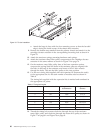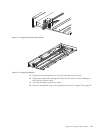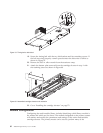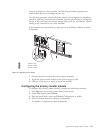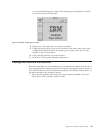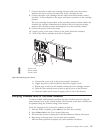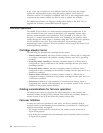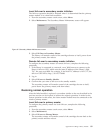
If any of the slave modules are at a different firmware level than the master,
update the multi-module system using the master module touch screen (if
firmware version 2.33 or higher is installed). Web TLC or the configuration utility
connected to the master module can also be used to update the modules.
For additional assistance on using the configuration utility or the Web TLC to
upgrade the firmware, contact IBM Technical Support.
Fail-over operation
The 4560SLX Tape Library in a multi-module configuration enables one of the
slave modules to take over control of the library as a temporary master if the
primary master module is not operational. This is referred to as fail-over. The
fail-over is a manual procedure that needs to be initiated by an operator, either
locally through the touch screen or remotely using Web TLC. A fail-over operation
can be initiated at any time. This section describes the terminology and
methodology used to initiate a fail-over operation, and to restore the library to its
normal operating condition.
Cartridge elevator terms
The following list describes the cartridge elevator terms:
v Primary master (active): An active primary master is a library that is configured
as a master, connected to the primary cartridge elevator port, and is operating
normally.
v Secondary master (standby): A standby secondary master is a library that is
configured as a slave, connected to the standby cartridge elevator port, and is
operating normally.
v Secondary master (active): An active secondary master is a library that is
configured as slave, connected to the standby cartridge elevator port, and is in a
failed-over condition.
v Primary master (inactive): An inactive primary master is a library that is
configured as master, connected to the primary cartridge elevator port, and is in
a failed-over condition.
v Failed-over: Failed-over is the condition of a multi-module library, where a
designated slave module will temporarily act as a master module in the event of
a failure of the primary master module.
Cabling considerations for fail-over operation
To enable proper fail-over operation, the SCSI connection to the primary and
secondary master should be daisy-chained. This enables the secondary master to
assume control of the SCSI bus when the primary master fails.
Fail-over initiation
In order for a fail-over operation to take effect, the library modules must be
correctly cabled to the cartridge elevator hardware, as described in “Cabling and
interface connections” on page 85:
v The master module must be connected as the primary master as shown in
Figure 85 on page 86.
v One of the slave modules must be connected as the secondary master as shown
in Figure 85 on page 86.
88 4560SLX Tape Library: User’s Guide



